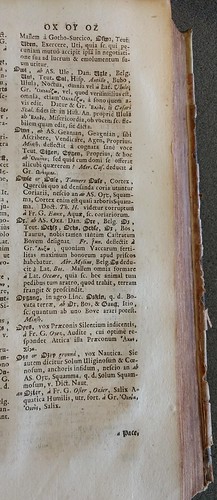Etymologicon linguae anglicanae - 1671
The 17th century saw an increase in the popularity of vernacular dictionaries and reference books and interest in vernacular languages as the objects of linguistic study. In England in particular interest in Old English increased after the separation from the Catholic Church, when the vernacular history was seen as a source for local theology in which to ground English religious and cultural separatism. Stephen Skinner's Etymologicon Linguae Anglicanae was one of several large undertakings on the history of English during the period, and Samuel Johnson relied on both it and Junius' Etymologicum Anglicanum for his own dictionaries—although he judged Skinner to be more accurate if less comprehensive[1]. English is the subject of study in the volume, but the language of scholarship is Latin; Skinner's prefaces and linguistic explanations, including the descriptions of sound correspondences between English and related languages, are in Latin.
References and Further Reading:
Considine, John. 2008. Dictionaries in early modern Europe: lexicography and the making of heritage. Cambridge, UK: Cambridge University Press.
Frantzen, Allen J. 1990. Desire for origins: new language, old English, and teaching the tradition. New Brunswick [N.J.]: Rutgers University Press.
Organization:
The text in the Etymologicon is in two columns, and entries are arranged alphabetically by English. "A" is introduced with a decorated capital, subsequent letters have plain, centered letter beginning each section. Column headings can be one or two pairs of letters which represent the beginning letters of the words in the column. One pair of letters is used if the entire column begins with the same pair, and two pairs if the column spans more than one pair. The heading does not necessarily strictly represent the beginning and end of the column; it often shows the middle and end, ignoring the first few words if they don’t fit. A single column may have up to three pairs of letters in a heading.
Roman typeface is used for language names and for Latin and Anglo-Saxon. Black letter (gothic) is used for the languages described in the text as Anglicana, Teutonica, Belgica, Sclavonica, Cambro Brittanica, Scythia Asiatici, and Turcae (probably referring to English, German, Flemish, Slavonic or Russian, Welsh, Iranian, and Turkish). Romance languages are set in italic typeface.
The book is a folio, with the gatherings of variable length, between one and three sheets (two to six leaves). Some of the signatures seem to have been printed in sections and the size of the signature adjusted so that a letter begins a signature. For example, 3Z is a six sheet signature which completes S, and T begins in signature 4A. Several other letters begin new signatures after irregular two-page signatures finish the last letter. However, other letters do begin mid-signature, so this is not consistent.
Bibliographic Information
Title
Date
Place
Publisher
Language
Contributor
Autograph
Imprint
Londini, Typis T. Roycroft, & prostant venales apud H. Brome [etc.] 1671.
On spine: Skinners Lexicon.
Condition
Leather over laminated paper boards is in poor condition. The book has been reinforced with a vellum half-binding. Marbled paper is glued over the leather. Paper inside has been glued to this marbled paper wrapper (the CRRS plate is affixed to this).
Printer’s device on π2v: WHITE-HALL, Sept. 7. 1668|By Permission and Licence of the Right Hono-|rable Sir William Morice, Principal Secreta-|ry of State, Let this ETYMOLOGI-|CON LINGUÆ ANGLICANÆ|be Printed.|JO. COOKE.
Several pages have small burn holes in them which obscure text. On pages 2L3, 4S2, and 5F3 and 4 handwritten notes fill in missing text. 3E1, 5S1 and 5S4 are missing some text due to the burn holes.
Signatures are signed in several typefaces and sizes.
Provenance
Plate on inside cover with crest reads: HIS UTERE MECUM. FIDELITER. Edward Balme Wheatley-Balme.
Plate on flyleaf: LIBER|COLLEGII ∙SELWYNENSIS|CANTABRIGIAE|____|EX∙DONO|EDWARDI∙BALME|WHEATLEY-BALME
Stamped over both plates: WITHDRAWN From Selwyn College Library. Handwritten in pencil: duplicate
On cover: B2 Sk.2 5115 folio (handwritten in pencil)
On flyleaf: J. Cutler. Several other words have been crossed out.
Price £12/12/- in pencil on flyleaf
Collation
Folio; π2, a2 ($1), B-D4 ($2), E- V2($2, – V2) 2A-2U4 ($2), 2X-2Z2 ($2), 3A-3Y4 ($2), 3Z6 ($3), 4A-5X4 ($2 – 5X2) final page is pasted to marbled wrapper.
Contents
π1v – Colophon/printer’s device
π2r – Title page
a1r – Editor ad Lectorem (Latin, set in Italics)
B1r – Praefatio ad Lectorem (Latin, set in Roman)
D3r – Prolegomena Etymologica, Canones Etymologici (Latin, set Rom., overview of sound changes)
D4v – Prolegomena Etymologica, exempla (correspondences between English words and other languages, with some attention to sound changes)
V2v – Linguae & Dialecti per totum Etymologicon citandae his notis compendia ergò indigitantur; Alphabetum Saxonicum
2A1r – Etymologicon Linguae Anglicanae
4G2r – Etymologicon Botanicum
4L3r – Etymologica Expositio
4U1r – Etymologicon Vocum omnium antiquarum Anglicarum
5K2r – Etymologicon Onomasticon
5X1r – Candide Lector








